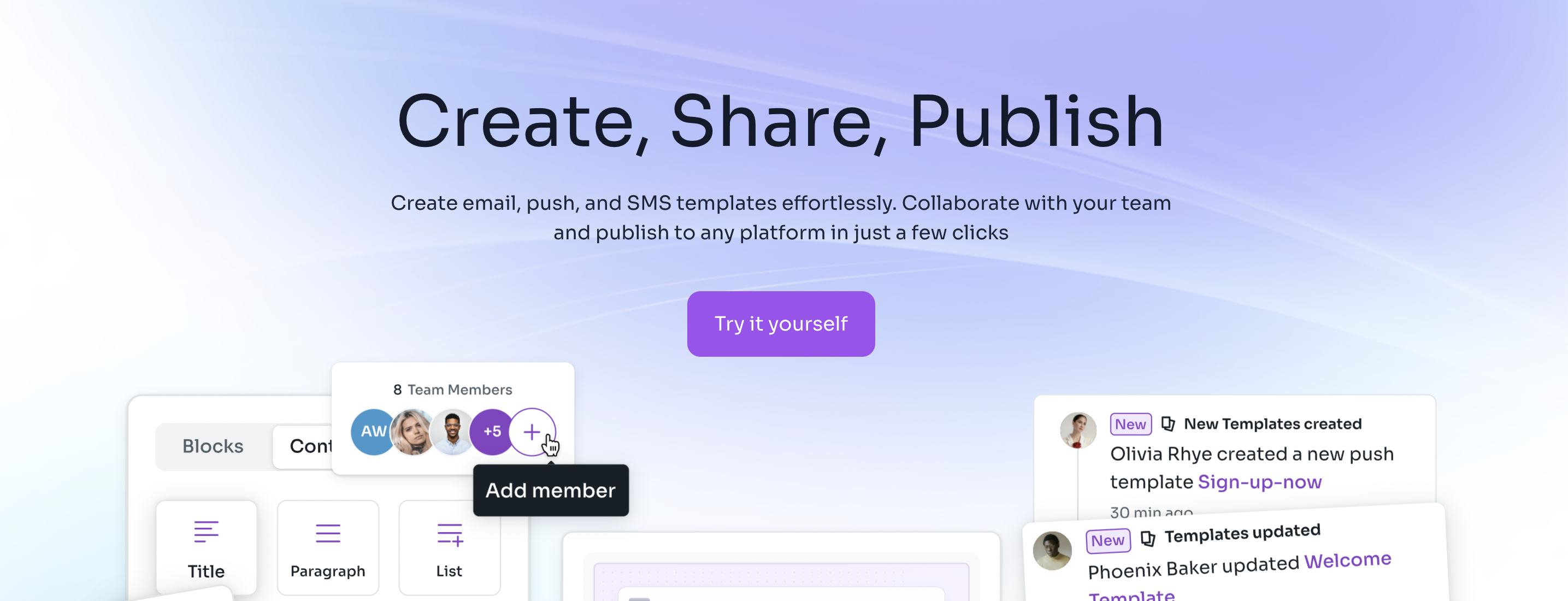28 Email Subject Line Best Practices for Better Open Rates
Email subject line best practices are crucial for email marketing success. What happens when you craft the perfect email, but no one opens it? You could have written the best content in the world, but if your email doesn't entice subscribers to open it, all that hard work will likely go to waste. This is the painful reality of email marketing. No matter how great your email is, if it doesn't entice subscribers to open it, all that hard work will likely go to waste.
With Blocfree's email template builder, you can craft stunning, engaging emails that improve email deliverability deliver results.
The Anatomy of a Great Email Subject Line

Creating a sense of urgency is often the best way to get your target audience’s attention. Why? The fear of missing out (FOMO) on an opportunity. If you want to convey a sense of urgency in your cold emails, you can use power words (and phrases), such as:
- Limited Time Offer
- Don’t Miss Out
- Last Chance
- Today Only
- Important
- Breaking
- Urgent
Now, keep in mind. You should avoid flooding your recipients’ inboxs with dozens of “urgent” emails. Instead, send emails that count down a window of opportunity.
Build Curiosity to Encourage Email Opens
Great subject lines can convey a sense of thrill and mystery. Still, there’s a fine line between sending an intriguing email and an obscure one.
For example, if you’re a marketing influencer, you might use the subject line “Wondering how I made $200K with YouTube?”
This brief subject line will pique your audience's curiosity when sending SEO outreach emails. A subject line that says, “I wonder what’s inside” is probably too enigmatic and off-putting.
When creating curiosity in your email subject lines, focus on the five dimensions of curiosity:
- Deprivation sensitivity: a knowledge gap that needs to be filled
- Joyous exploration: fascination with a subject or concept
- Social curiosity: a desire to learn more about other people
- Stress tolerance: the willingness to embrace confusion, doubt, and other forms of distress
- Thrill-seeking: a desire for adventure
Use Email Subject Lines to Highlight Offers
Everyone loves a reward. It’s the basis of human psychology. You can use a subject line to highlight a new deal, incentive, or promotional offer.
For example, the subject line “Free Shipping on [product]” entices recipients to place their order to save on shipping costs. People love discounted and free items, especially if their inboxes contain hundreds of other useless or junk messages.
Personalize Your Email Subject Lines
Personalization is an integral component of any email marketing campaign. When you refer to your recipients personably, they are more inclined to open your emails.
Examples of email personalization include “Tracy, we missed you.” Calling someone by their first name is an excellent way to break down the barriers of corporate communications and get their attention.
Email Subject Lines Should Be Timely and Relevant
The email's subject line must also be relevant to the recipient’s daily life. Otherwise, you’ll send irrelevant email content and have them end up in the spam folder.
Here’s an example of a timely email subject, “Outdoor lighting solutions for summer.” Outdoor lighting is a popular home improvement product for summertime to enjoy the outdoors in the warm weather (even after the sun has gone down).
This also works well as an email warmup strategy, where you segment your email list and send a timely email promotion to improve your sender reputation.
Optimize Subject Line Length for Email Success
Length is one of the most important aspects of a great subject line. A popular misconception is that short subject lines always perform better than longer ones.
A 2021 Gartner study found that longer subject lines (70 characters) performed competitively with shorter ones. To find the best length for your campaign, you should run an A/B test to make a data-driven decision.
Your Versatile Email Template Builder
Create, share, and publish easily with Blocfree's email template builder. Blocfree is an email HTML editor that allows you to quickly create/edit emails and use it with multiple platforms like:
- Mailgun
- Sendgrid and others
Effortlessly craft email, SMS, and push templates with our intuitive email template builder. Collaborate seamlessly with your team and quickly publish content to your preferred platform.
Use Blocfree's email template builder for free today!
Related Reading
28 Email Subject Line Best Practices

1. Keep It Short and Sweet
When it comes to email subject lines, less is more. Aim for around three words. Twilio SendGrid has analyzed emails sent through our system, and our subject line data reveals that recipients prefer and will be more likely to open a subject line when it’s three words. Does that mean if you think you have the perfect subject line at four words, you should change it around completely? No, guidelines and trends are just that—they are not a universal law.
Still, finding yourself in a writer’s block? Consider putting a spin on puns or easily recognizable phrases. Although these phrases are trite and lazy by themselves, when you alter or put a personal spin on a pun applicable to your brand or service, you usually catch people’s attention because they were expecting to read something else.
The following subject line from a smoothie delivery company puts a twist on the phrase,
“No way, Jose.”
Re: Yes way, Frose!
The accompanying email included cocktail recipes that you could make with its smoothies—one of which is a rose smoothie. I am opening that email!
Compelling Email Subject Lines
You only have 50-70 characters to work with so get to the point quickly. Note that it is only 40-50 characters if the message is displayed on a mobile device. Keep your subject lines as close to 50 characters as you can. If it’s too short, then it’s less likely to make the recipient want to open.
2. Write the Subject Line Last
When pulling together an email campaign, you may have an idea for your subject line. But until you’ve selected all copy pieces and written accompanying snippets and headlines, you won’t have the full picture of what you’re trying to explain. And as a result, distilling your content into one line of text will prove quite challenging.
There are, of course, exceptions to this tip. Sometimes, a flash of brilliance occurs and the subject line almost writes itself before finishing other steps. For cases when that doesn’t happen, wait until you've finalized every other piece of content before attacking the headline or subject line.
3. Be Specific—and Urgent
Think of the subject line as your first CTA or touchpoint with your recipient. You've lost them if you don’t draw them right away. And while humor and wit are usually rewarded, remember to give your recipient some taste of what’s inside. To achieve this, try to use action verbs that resonate with your audience as much as possible.
Verbs are a writer’s best friend because they help you do more with less, which will always be in your favor. I recently received an email from Strava that draws on the inherently competitive nature of Strava users and uses an appropriate verb in its subject line:How fast can you run a mile?
4. Experiment with Your Approach
No single (legal) email list is the same, meaning you won’t know how your audience will react to your subject lines until you send them something. Fortunately, subject lines are some of the simplest email components to test. Consider sending two or more subject lines to different email list segments.
One subject line may be a bold subject line that pushes the envelope, while the other could be a more traditional and literal subject line. The options are endless. For more on testing and experimenting in your campaigns, read up on some common questions and answers to A/B testing.
5. Avoid Excessive Frills
We’re likely guilty of adding in exclamation points or being tempted to WRITE IN ALL CAPS TO GET OUR POINT ACROSS. We use these language tools to help us emphasize, but often these tactics lose or agitate the recipient. Tread extra lightly when considering hitting your caps lock or using excessive exclamation points or other symbols. Allow your subscribers to react to the meat of your copy instead of the frills.
One modern exception to this rule, depending on your industry, is using emojis. Emojis can work great for some campaigns (such as marketing to millennials). For others, they fall flat. See the previous tip about testing to find the right balance for your email program. Emojis also allow you to use fewer characters, so if they work for your engagement, go for it.
6. Have Fun
Don’t forget that writing subject lines can be fun and a great place to explore/try new things with your writing style. Subject lines are short but mighty nuggets of content that set the pace for all following email engagement events.
7. Personalization
Incorporate the recipient's name or other personalized details when relevant. Personalized subject lines stand out and feel more appropriate to the recipient.
8. Relevance
Make sure your subject line aligns with the content of the email. Misleading subject lines can lead to unsubscribes or recipients marking your emails as spam.
9. Curiosity
Pique the recipient's curiosity by using intriguing phrases or asking questions that leave them wanting to know more.
10. Value-oriented
Highlight the benefits or value the recipient will gain from opening the email. How will they be better off after reading it?
11. Actionable language
Use action-oriented verbs and phrases that encourage recipients to take action, like:
- Get started
- Discover
- Learn how
12. Segmentation
Tailor your subject lines to different audience segments, addressing their specific needs or interests.
13. Emoji Use
In some cases, emojis can add visual appeal and personality to subject lines. However, use them sparingly and make sure they're relevant to the content.
14. Test Different Approaches
Experiment with various subject lines to see what resonates best with your audience. Examples could include humor, emotional appeals, or straightforward descriptions.
15. Numbers and Lists
Subject lines with numbers (e.g., "10 Tips for...") tend to attract attention because they suggest a clear and organized format for the content within the email.
16. Trendy
Incorporate references to trending topics, memes, or cultural events, but only if relevant to your content and audience.
17. Wordplay
Play with words, puns, or humor that align with your brand's tone and personality.
18. Show Your Brand’s Personality
It’s crucial to clearly understand your brand’s tone of voice before crafting your subject lines. The tone employed in communication plays a pivotal role, and deviating from the expected tone can jeopardize the brand-customer relationship and potentially result in a loss of future business.
Maintaining a clear and consistent tone that aligns with your brand image and meets customer expectations fosters a lasting relationship. This approach to writing email subject lines ensures ongoing engagement and satisfaction for both parties.
19. Ask Questions?
Questions naturally stimulate curiosity and encourage recipients to open the email to find the answer. Questions can help to establish a sense of relevance by addressing the recipient’s needs or interests. At the risk of sounding like a broken record, it is important to ensure that the question is relevant to the content of the email.
Don’t be that person; don’t deceive people with clickbait. It can work and make the recipient open the link for once, but you do not want an annoyed audience that will mark you as spam and won’t read another email from you.
20. Try Alliteration, Consonance or Rhyming
These literary devices are popular in songwriting and creative literature as well as email subject lines because they break the monotony and add memorable elements. Just don’t go overboard! Remember that you’re writing email subject lines and not beat poetry.
- Better: 5 Fall Fashion Don’ts for 2019
- Worse: 5 Fall Fashion Faux Pas for Females
21. Don’t Get Too Excited
All caps and punctuation marks are fine in moderation. When you overdo either, you don’t convey excitement as much as your impart anxiety.
- Better: Enjoy FREE delivery for purchases $100 and above today!
- Worse: $100 WORTH IN YOUR CART??? ENJOY FREE DELIVERY ON US!!!
22. Make a Personal Connection
Personalizing email subject lines leads to better open rates. It’s also very easy to do at a basic level: Include the subscriber’s name in the text. Advancements in technology can also help add more personal touches that draw from geographical location or buying behavior.
- Better: “Thanks for participating in our Labor Day Sale, Maria!”
- Worse: “Here’s the online receipt of your Labor Day Sale purchases.”
23. Spell Check Your Subject Line
If your word processing software says there’s a problem, then there is a good chance that it will be flagged as suspicious when sending the email.
24. Make The Pre-header Work With The Subject Line
- Subject line: Have you ever seen wild dolphins?
- Pre-header: Come visit our dolphin sanctuary. Learn more about these majestic creatures
25. Avoid The ‘No-reply’ Sender Name
Thanks to the amount of spam people get, most people hesitate to open emails from unfamiliar senders. Even fewer people enjoy talking to a robot. Think about when you call a company and can't get a hold of an actual person. It's frustrating, right?
This is the same for email. Never use “[email protected].” Not only does it look less personable, but it also stops people from adding your email to their address book. Instead, avoid using a generic email address and send the email from a real person.
26. Segment Your Lists
While email blasts sent to your entire list might be relevant and helpful to some people, they won't be to others, causing confusion and frustration.
- Why is this restaurant sending me a list of the best local steakhouses when I'm a vegetarian?
- Why did this company send me case studies when I signed up for its email list yesterday?
This is where segmentation comes in. Organizing your email list using personalization and preferences increases your subscribers' desire to open your email. Gartner found that 53% of consumers like emails that share local or regional events and offers. In email marketing, you can personalize your recipients' experience using a little thing called list segmentation.
27. Time It Right
Do you need something tasty for lunch? Sending an email with the right subject line at the right time can greatly affect open and click-through rates.
When food publication Eater sent an email at 6:45 P.M. on a Wednesday that said, “Where to Drink Beer Right Now” — it was just in time for happy hour. Nailed it. Or, in the example above, IRC Recipes sent an email during the day that asked, “Need something tasty for lunch?” The day of the week matters as well. Tuesdays have the highest email open rates nearly 27%, compared to Sundays, with the lowest open rates (4%).
Another favorite example is a classic email from Warby Parker with the subject line, “Uh-oh, your prescription is expiring.” It was sent two weeks before the recipient needed to renew his prescription. By sending an email at the right time, Warby Parker increased the chances of their email getting opened, and they included a relevant call-to-action about getting a glasses upgrade.
28. Reach Out Again
A common problem in email marketing is that readers don’t open your emails despite your best efforts. Current stats demonstrate that marketers are missing out on further engagement. When retargeting, make this known in your subject line with something like “Oops, looks like you missed this!” or “Don’t forget to sign up for this Friday’s webinar” or whatever you’d like a missed target to acknowledge.
Use Our Email Template Builder for Free Today
Blocfree has created a handy tool for email marketers. Their email template builder lets you easily create, edit, and customize email templates for your marketing campaigns. The best part? You can use your new template with multiple email platforms like Mailgun and Sendgrid. More than just an email HTML editor, Blocfree also helps you build SMS and push notification templates to help you create cohesive marketing campaigns.








